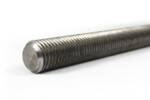Greg's FAQs

F1554 Grade 36 All Thread Rod
Does commercially available mild steel all thread rod meet ASTM F1554 grade 36?In almost all cases, commercially available all thread rod will not meet F1554 grade 36. First, it is rare that distributors or manufacturers keep lot control on all thread rod. In other words, different heats of all thread rod are commingled so that it is difficult to determine the exact certification document that corresponds to... Read more
Large Diameter SAE Bolts
Are SAE Grade 2, 5, and 8 bolts available in diameters over 1½"?No, the SAE J429 specification only covers bolts up to and including 1½” diameter. SAE J429 (1999), the specification that includes Grade 2, 5, and 8 fasteners, states: “This SAE standard covers the mechanical and material requirements for inch-series steel bolts, screws, studs, SEMS, and U-bolts used for automotive and related industries in sizes to... Read more
A325T
What is an A325T bolt?An A325T bolt is a fully threaded version of an F3125 grade A325 heavy hex structural bolt. The F3125 specification is very specific when it addresses thread lengths. Standard A325 bolts have very short thread lengths due to their application as a bolt intended for use in structural steel connections since often it is undesirable... Read more
Bolt Thread Pitch Series
What are my thread pitch options when ordering bolts?There are several different thread series available for construction fasteners. Below are the three of the most common thread series utilized in the fastener industry. Coarse Thread Series Unified National Coarse (UNC) – Coarse threads have fewer threads per axial distance than fine threads and a larger thread form relative to the diameter. Coarse thread... Read more
Galvanizing Bolts for Pressure Treated Wood
Are current ASTM galvanizing standards suitable for use with the new chemicals being used in pressure treated wood? Some people have told me I need to use double or triple dipped fasteners. Is this true?Since the new chemicals (alkaline copper quat [ACQ], copper azole [CBA-A and CA-B], and sodium borates [SBX]) now being used in pressure treated wood have been shown to be up to two or three times more corrosive than the previously used chromate copper arsenate (CCA), the recommended galvanizing thickness for materials being used with the... Read more
Galvanized Bolts and Chased Threads
Can threads be chased after hot-dip galvanizing for proper nut fit?Absolutely not! Externally threaded fasteners should never be “chased”. During the hot-dip galvanizing process, excess zinc has a tendency to build up in the threaded portion of a fastener. Chasing threads is a term used to describe re-cutting threads after galvanizing to remove this excess zinc that has accumulated during the galvanizing process. Chasing threads... Read more
SAE Grade 8 markings
What visual markings does a grade 8 piece of all thread rod have that would identify it as being so? Meaning, how can you tell just by looking at a stick that it's grade 8?Most grade 8 bolts require a permanent marking symbol that is designated by 6 radial lines. However, the SAE J429 specification that covers grade 8 fasteners does not require grade markings for studs (fully threaded rods) or slotted and cross recess head products. Therefore, you will not be able to visually identify a threaded stud... Read more
ASTM and SAE Differences
What are the main difference between ASTM 307 GR.B, ASTM A449, and SAE Grade 5 bolts?There are two specifying bodies when it comes to fasteners. ASTM (American Society for Testing and Materials) covers primarily bolts and fasteners for construction applications. SAE (Society of Automotive Engineers) covers fasteners for automotive, machinery, and OEM applications. ASTM A307 grade B is made from a low carbon steel and is a relatively low strength... Read more
ASTM A325 vs A449
I have two items that use 1" bolts, one is ASTM A325 and the other is ASTM A449, I would like to just use one. Which is the one that meets or exceeds the other?These bolts are identical with regard to strength and chemistry. There are very minor differences in the hardness requirements, but the proof load, tensile, and yield strength requirements are the same. From a manufacturing standpoint, we make these bolts using the same raw material and the same heat treating and production methods. Our strength by... Read more

Concerns Calculating Torque
How do I calculate torque for construction fasteners?Torque is a difficult value to calculate accurately, especially for construction fasteners and should be used cautiously. The primary challenge is accounting for environmental factors, coatings, and a number of other variables including surface texture, material hardness, and thread series. In most situations, it is challenging to give reliable allowable torque values for bolted assemblies.... Read more

